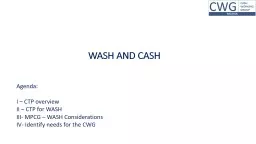

II CTP for WASH III MPCG WASH Considerations IV Identify needs for the CWG Grand Bargain agreement at the 2016 World Humanitarian Summit the use of cash transfers has become a key component of humanitarian assistance ID: 786870
Download The PPT/PDF document "WASH AND CASH Agenda: I – CTP overview" is the property of its rightful owner. Permission is granted to download and print the materials on this web site for personal, non-commercial use only, and to display it on your personal computer provided you do not modify the materials and that you retain all copyright notices contained in the materials. By downloading content from our website, you accept the terms of this agreement.
Slide1
WASH AND CASH
Agenda:
I – CTP overview
II – CTP for WASH
III- MPCG – WASH Considerations
IV- Identify needs for the CWG
Slide2“Grand Bargain agreement at the 2016 World Humanitarian Summit: the use of cash transfers has become a key component of humanitarian assistance.
There is strong evidence and consensus that cash transfers are efficient and effective in covering basic needs.”Impact of Cash on Nutrition Outcomes, WFP, Action Against Hunger.
Slide3I – Cash-based Transfer Programming overview
Slide4Unconditional CTs
(UCTs): no conditions attached to them, with the exception of broadly defined eligibility categories (
i.e.,only
a defined subpopulation such as victims of a disaster are eligible).
Conditional CTs
(CCTs): require recipients to fulfil specific prescribed criteria (sometimes also called co-responsibilities), such as using a specific health service or attending education.
- CCTs with ’hard’ conditions (where non-compliance with conditions results in penalties)
- CCTs with ’soft’ conditions (where non-compliance does not result in penalties)
Slide5Restrictions:
Unrestricted: Cash can be used to meet any need. (cash in envelop, ATM cards, vouchers for cash, mobile money etc
…)
Restricted:
Voucher can be used only for selected items/services. (e-vouchers, paper-vouchers, contract with health service provider
etc
…)
Slide6II – Cash-based Transfer Programming for WASH
Interventions designed to achieve WASH Objectives.
Slide7Indicators in HRP:
Number of Households receiving cash transfers and or vouchers to meet water needs as per sector’s standard (Target: 10,000)Number of Households receiving cash transfers and or vouchers to meet their
hygiene items needs
including top-ups
(Target: 10,000)
Slide8CTP for Hygiene Items and/or water needs:
Available studies on N.E Nigeria: ROAP (Response Option Analysis and Planning), September 2017Activities:Distribution of restricted vouchers for hygiene items, including top-ups. (unconditional or conditional, restricted)
Distribution of restricted vouchers for water (unconditional or conditional, restricted)
Cash grants to water vendors to improve their equipment (conditional, restricted/unrestricted)
To achieve WASH specific objectives, unrestricted & unconditional is not an option.
Look at restrictions and conditionalities (could be cash, vouchers or a mix)
Conditionality considerations
:
Attending Awareness raising / Hygiene promotion sessionsFor water vendors: submit improvement plan, verification of water quality before receiving the 2d tranche.Restriction considerations:- e-vouchers at specific and selected vendors / water vendors (enable control of the quality of goods by the organization).
Slide9Complementary activities:
Available studies on N.E Nigeria: ROAP (Response Option Analysis and Planning), September 2017Maintenance of water infrastructure
Monitoring and sensitization to water vendors of water quality (at source and during transportation)
Supporting water traders’ association to enforce standards
Awareness raising sessions on hygiene
Slide10Necessary activities for such interventions:
Market and water services assessments (e.g: availability of hygiene items)Development of contracts with selected water services companiesVulnerability assessment Analysis to identify delivery mechanismDevelop M&ERisk assessment with mitigation measures : training to health service providers on their obligations, information of penalties/termination in case of fraud, communication to beneficiaries on their rights
etc
…
In coordination with government development of national standards for emergency cash distribution, and coordination of cash/voucher programmes (e.g.: ToR of cash working group),
Establishment of ad-hoc cash working group that aim to facilitate coordination on cash
Communication and promotion
Slide11III- Multi-Purpose Cash Grant – WASH considerations
Slide12MPCG: Unrestricted and unconditional.
Objective: Improve access to
Basic Needs
.
Necessity to do a Minimum Expenditure Basket (MEB) to have an estimate of the expenses of a household to set-up the transfer value.
Look at
monthly recurrent expenses
(not one-off), that a household is
likely
to purchase.
Slide13Items
Quantity
Unit
MMC
Jere
Konduga
Monthly Average
WASH
Water (water vendor fee, 20L jerrycan)
158.00
jerrycans
10.00
10.00
10.00
1,580.00
Bathing soap, 250 grams
3.00
pcs
178.57
156.67
200.00
535.24
Laundry soap, 200 grams
6.00
pcs
128.57
106.67
100.00
670.48
Sanitary pads (disposable, for adolescent girls)
1.00
pkt 1,340.33 1,310.60 512.50 1,054.48 Sub Total 1,657.47 1,583.94 822.50 3,840.20
WASH related expenses
Slide14MPCG can help in accessing the services or the item, but has no impact on the quality + no restriction on choice of provider, hence need for coordination/complementarity with WASH sector :
Verify availability and quality of water in targeted communities
Accompanying activities: Sensitization (
etc
… like in CTP)
Expected outcome: improvement in access to water and hygiene items
Monitoring:
> % of beneficiary households reporting adequate access to water, as defined by Sphere standards
> % of beneficiary households reporting adequate access to hygiene items
Slide15IV- How can the CWG work with the WASH Sector?
Proposition:
Work with partners to develop Harmonized tools/guidelines for CTP (create a Task Team?)
Look at Joint Market Price Monitoring for hygiene items
Any other needs?
Slide16Resources for Cash and WASH
Market Analysis and impact measurement in CTP in the WASH and the Shelter sectors (CaLP, April 2016)https://www.dropbox.com/s/38c7727vry7mwtc/Market%20analysis%20and%20impact%20measurement%20-%20CTP.pdf?dl=0
Cash Transfers: What does the evidence say? (July 2016)
https://www.dropbox.com/s/77leon9ex6r4pg2/cash-transfers-what-does-the-evidence-say-report.pdf?dl=0
UNHCR – Cash for Latrines.
https://www.dropbox.com/s/f94ozxrxmrhjzms/UNHCR%20cash%20for%20latrines%20-%20key%20learnings%20and%20checklist.pdf?dl=0
Cash and Vouchers – Implementation Manual (WFP)
https://www.dropbox.com/s/pwklwrnplznhx9h/Cash%20and%20Voucher%20Manual%20-%20WFP.pdf?dl=0
General:The CaLP (Cash Learning Partnership): http://www.cashlearning.org
Slide17Contacts of the Cash Working Group:
Coordinator:
Ayo Ajayi:
ayobamidele@un.org
Technical co-lead:
Gabrielle Viat:
gabrielle.viat@crs.org
; 07035722387 -